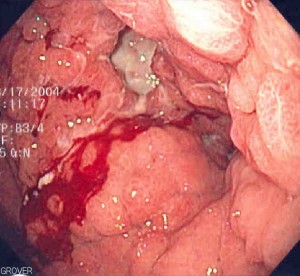Lit of the Week – 5/3/16
Glasgow Blatchford Bleeding Score
Blatchford O, Murray WR, Blatchford M. A risk score to predict need for
treatment for upper-gastrointestinal haemorrhage. Lancet. 2000 Oct
14;356(9238):1318-21. PubMed PMID: 11073021
Clinical question / background:
- Can a risk score based on medical history, hemodynamic variables, and simple lab data risk stratify patients presenting with upper GI bleed to the emergency department?
Design:
- Retrospective development of scoring system using logistic regression of objective data from large patient database followed by prospective validation using ROC curves compared to Rockall scoring and post-endoscopy scores
- 1748 patients with UGIB in retrospective group
- 19 hospitals in Scotland
- 197 patients with UGIB in validation group
- 2 hospitals in Scotland
- Primary outcome: clinical intervention
- Blood transfusion
- Any operative or endoscopic procedure to control bleeding
- Death, re-bleed, or substantial fall in hemoglobin after admission
Intervention:
- Evaluation of Scoring system as detailed below
| Glasgow-Blatchford Score | |
| Admission risk marker | Score component value |
| Blood Urea (mmol/L) | |
| 6.5-8.0 | 2 |
| 8.0-10.0 | 3 |
| 10.0-25 | 4 |
| >25 | 6 |
| Hemoglobin (g/L) for men | |
| 12.0-12.9 | 1 |
| 10.0-11.9 | 3 |
| <10.0 | 6 |
| Hemoglobin (g/L) for women | |
| 10.0-11.9 | 1 |
| <10.0 | 6 |
| Systolic blood pressure (mm Hg) | |
| 100–109 | 1 |
| 90–99 | 2 |
| <90 | 3 |
| Other markers | |
| Pulse ≥100 (per min) | 1 |
| Presentation with melena | 1 |
| Presentation with syncope | 2 |
| Hepatic disease | 2 |
| Cardiac failure | 2 |
Score
Score is equal to “0” if the following are all present:
- Hemoglobinlevel >12.9 g/dL (men) or >11.9 g/dL (women)
- Systolic blood pressure>109 mm Hg
- Pulse<100/minute
- Blood urea nitrogen level <6.5 mg/dL
- Nomelena or syncope
- No past or presentliver disease or heart failure
Results:
- area under the ROC curve of GB score was 0·92 (95% CI 0·88–0·95), which was significantly higher than that for Rockall admission (0·71 [0·64–0·78]) and the full postendoscopy scores (0·75 [0·67–0·83]
- GB score more highly correlated with need for blood transfusion and hospital length of stay
Take-Home
- In patients presenting with signs/sxs of acute UGIB, the GB score can be used to risk stratify them for need for further intervention
Strengths:
- Easy to use based on common admission lab data
- META-analysis found that score of 0 was associated with a low likelihood of the need for urgent endoscopic intervention (likelihood ratio 0.02, 95% confidence interval [CI] 0-0.05)
Limitations
- Only applicable for acute UGIB
- Score of 1 or greater indicates probable need for intervention limiting its use if patients with chronic anemia, renal disease
Real World
- Score 0
- Low risk for intervention
- Reasonable to manage as outpatient
- Score >0
- Increased risk for intervention and inpatient management is recommended
- However most cases <5 respond without significant intervention
- Score >5
- High risk for intervention

